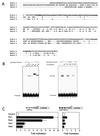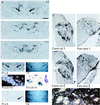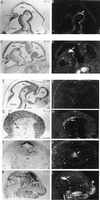A homeodomain gene Ptx3 has highly restricted brain expression in mesencephalic dopaminergic neurons
- PMID: 9371841
- PMCID: PMC24304
- DOI: 10.1073/pnas.94.24.13305
A homeodomain gene Ptx3 has highly restricted brain expression in mesencephalic dopaminergic neurons
Abstract
The mesencephalic dopaminergic (mesDA) system regulates behavior and movement control and has been implicated in psychiatric and affective disorders. We have identified a bicoid-related homeobox gene, Ptx3, a member of the Ptx-subfamily, that is uniquely expressed in these neurons. Its expression starting at E11.5 in the developing mouse midbrain correlates with the appearance of mesDA neurons. The number of Ptx3-expressing neurons is reduced in Parkinson patients, and these neurons are absent from 6-hydroxydopamine-lesioned rats, an animal model for this disease. Thus, Ptx3 is a unique transcription factor marking the mesDA neurons at the exclusion of other dopaminergic neurons, and it may be involved in developmental determination of this neuronal lineage.
Figures




References
-
- Lumsden A, Krumlauf R. Science. 1996;274:1109–1115. - PubMed
-
- Tanabe Y, Jessell T M. Science. 1996;274:1115–1123. - PubMed
-
- Specht L A, Pickel V M, Joh T H, Reis D. J Comp Neurol. 1981;199:233–253. - PubMed
-
- Voorn P, Kalsbeek A, Jorritsma-Byham J, Groenewegen H J. Neuroscience. 1988;25:857–887. - PubMed
-
- Solberg Y, Silverman W, Pollack Y. Dev Brain Res. 1993;73:91–97. - PubMed
Publication types
MeSH terms
Substances
Associated data
- Actions
LinkOut - more resources
Full Text Sources
Other Literature Sources
Molecular Biology Databases
Research Materials
Miscellaneous

